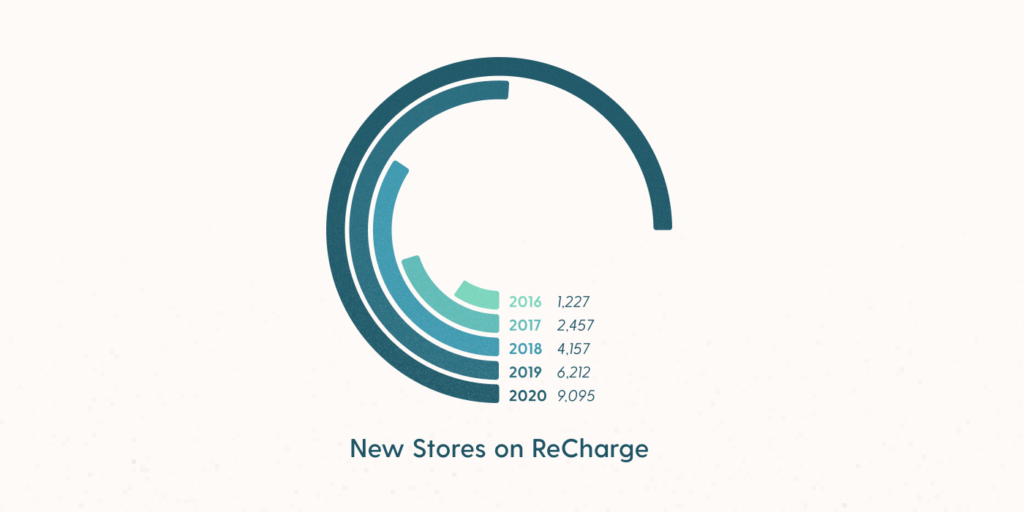We are excited to announce that our annual State of Subscription Commerce Report is officially live! This year’s report centers around the challenges and opportunities of 2020, and how merchants were able to meet their customers where they were to reach new levels of success.
2020 brought a pandemic and with it many challenges, all of which forced consumers into their homes and away from traditional shopping experiences. This resulted in explosive growth for the subscription commerce industry in every facet: average order value, customer lifetime value, and subscription rates.
What’s in The State of Subscription Commerce Report?

The methodology of the report
Working with our skilled team of data scientists, we analyzed a large number of merchants processing with Recharge to understand key themes and trends that took place in 2020. Our merchants studied spanned every vertical, globally, totalling to 9,000 stores shipping to over 20 million subscribers.
The impact of 2020 on subscription commerce and YOY growth
In this section, we wanted to understand how one year contributed to such astronomical growth in the subscription commerce space. We leveraged the data pulled from last year’s report (data from 2019), and paired that with the new data collected from 2020 to develop year-over-year growth percentages. For example, we were able to find that we saw a 91% increase in subscribers year-over-year.
Another area of study was the growth in average order value (AOV) and customer lifetime value (LTV), both of which saw cumulative increases in 2020. However, even with more stores in the overall market, AOV trends showed interesting shifts- most growing, with some slightly declining.

Brick & mortar to ecommerce
As customers were spending their time in their homes, traditional brick & mortar shopping began to shift online. Companies like The Sill and General Assembly Pizza pivoted to meet the needs of their customers, delivering directly to their doorsteps. In fact, Recharge merchants increased by over 3,000, many of which were traditionally brick & mortar.
Breaking down the top, middle, and bottom tiers
A big change from last year’s report to this year’s was the evaluation of the top, middle, and bottom tiers of merchants. We split the entire studied merchant pool into thirds by gross merchandising value (GMV) and analyzed what made the top-tier so successful. Comparatively speaking, the top-tier had not only higher GMV, but higher AOV, LTV, MRR, and subscriber counts.
Analyzing the top-tier merchants
Once we understood the difference between tiers, we wanted to take a closer look at the top-tier to understand what they were doing differently in hopes we could provide all merchants with takeaways to offer in their own businesses.

The top-tier success boiled down to 3 key areas:
- Cultivating customer loyalty- These top-tier merchants often had a greater brand purpose that customers could get behind. Additionally, they often built strong communities that made the customer experience more than just purchasing product.
- Leveraging integrations- Not surprisingly, top-tier merchants had a large tech stack to support their business and their customers at every touchpoint. We were able to identify the top integrations these merchants used and provide insight as to what they were and how they’re utilized.
- Offering flexibility– As a consumer, this is one of my personal favorites from the brands I subscribe to. Top-tier merchants accounted for almost all of the flexible checkout options performed in 2020. They allowed customers to skip a subscription, swap products, or purchase a one-time item, which gave their subscribers control, yet also increased AOV and LTV with cross-sells and upsells.
Conclusion
The playing field for subscription commerce has risen to a new level, altering the baseline. Merchants will have to continue to find ways to pivot, innovate, and offer customers experiences that feel unique and memorable to stay ahead of the ever-growing pool of brand and consistently maintain YOY growth.
Access our key insights and takeaways on a monumental year. Download the report here.




